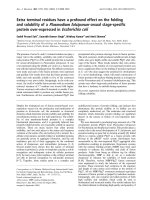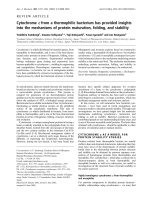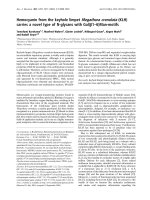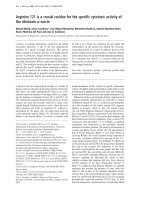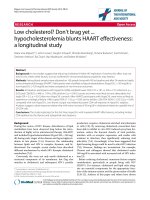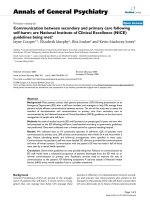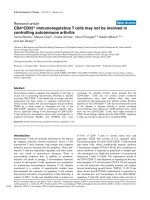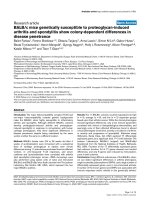Báo cáo y học: "If you don''''t believe it, it won''''t help you": use of bush medicine in treating cancer among Aboriginal people in Western Australia" pps
Bạn đang xem bản rút gọn của tài liệu. Xem và tải ngay bản đầy đủ của tài liệu tại đây (558.4 KB, 9 trang )
JOURNAL OF ETHNOBIOLOGY
AND ETHNOMEDICINE
Shahid et al. Journal of Ethnobiology and Ethnomedicine 2010, 6:18
/>Open Access
RESEARCH
© 2010 Shahid et al; licensee BioMed Central Ltd. This is an Open Access article distributed under the terms of the Creative Commons
Attribution License ( which permits unrestricted use, distribution, and reproduction in
any medium, provided the original work is properly cited.
Research
"If you don't believe it, it won't help you": use of
bush medicine in treating cancer among
Aboriginal people in Western Australia
Shaouli Shahid*
1,2
, Ryan Bleam
1
, Dawn Bessarab
1,2
and Sandra C Thompson
1,2,3
Abstract
Background: Little is known about the use of bush medicine and traditional healing among Aboriginal Australians for
their treatment of cancer and the meanings attached to it. A qualitative study that explored Aboriginal Australians'
perspectives and experiences of cancer and cancer services in Western Australia provided an opportunity to analyse
the contemporary meanings attached and use of bush medicine by Aboriginal people with cancer in Western Australia
Methods: Data collection occurred in Perth, both rural and remote areas and included individual in-depth interviews,
observations and field notes. Of the thirty-seven interviews with Aboriginal cancer patients, family members of people
who died from cancer and some Aboriginal health care providers, 11 participants whose responses included
substantial mention on the issue of bush medicine and traditional healing were selected for the analysis for this paper.
Results: The study findings have shown that as part of their healing some Aboriginal Australians use traditional
medicine for treating their cancer. Such healing processes and medicines were preferred by some because it helped
reconnect them with their heritage, land, culture and the spirits of their ancestors, bringing peace of mind during their
illness. Spiritual beliefs and holistic health approaches and practices play an important role in the treatment choices for
some patients.
Conclusions: Service providers need to acknowledge and understand the existence of Aboriginal knowledge
(epistemology) and accept that traditional healing can be an important addition to an Aboriginal person's healing
complementing Western medical treatment regimes. Allowing and supporting traditional approaches to treatment
reflects a commitment by modern medical services to adopting an Aboriginal-friendly approach that is not only
culturally appropriate but assists with the cultural security of the service.
Introduction
Indigenous Peoples' concept of health and survival is both
the collective and individual inter-generational contin-
uum encompassing a holistic perspective incorporating
four distinct shared dimensions of life, which are the spiri-
tual, intellectual, physical, and emotional. Linking these
four fundamental dimensions, health and survival mani-
fests itself on multiple levels where the past, present and
future co-exist simultaneously[1]
The holistic health care system has been practiced by
people from different ethnic and cultural background
worldwide[2]. While these health systems in various parts
of the world share certain characteristics that distinguish
them from biomedicine, approaches to health and heal-
ing are diverse and changing over time. Nevertheless,
some commonalities can be distinguished [3]. In Austra-
lia (as elsewhere), Aboriginal people have relied on plants
for many of their needs, including as a medicine in treat-
ing their ailments[4]. Aboriginal and Torres Strait
Islander people are the Indigenous people and original
inhabitants of Australia. In this paper, 'Aboriginal' has
been used to refer to the Aboriginal and Torres Strait
Islander people who are traditional inhabitants and
Indigenous people of Australia. 'Indigenous' has been
used when we refer to descendents of the native or first
nation inhabitants of other countries prior to European
* Correspondence:
1
Centre for International Health, Curtin University, GPO Box U1987, Perth WA
6845, Australia
Full list of author information is available at the end of the article
Shahid et al. Journal of Ethnobiology and Ethnomedicine 2010, 6:18
/>Page 2 of 9
colonisation. Since colonisation, the lifestyles of Aborigi-
nal Australians have endured significant change through
dispossession of land, social disruption, racism, cultural
suppression and discriminatory government policies[5].
Consequently, people's usage of plants and maintenance
of traditional cultural beliefs and practices, including tra-
ditional medicine and healing practices[6] have varied
according to the impact of colonisation on their connec-
tion to country and culture. Previous research confirming
the use of traditional medicines[6,7] by Indigenous peo-
ple have recognized that failure to understand and com-
municate about such usage may result in patients'
dissatisfaction and non-compliance with existing bio-
medical treatment services[8,9]. This however, has not
translated to mainstream health service providers who
appear to have little recognition and acknowledgement of
the belief in and use of traditional healing practices and
medicines by Indigenous patients[10,11].
This analysis arose in the context of a research project
that aimed to explore the beliefs, understanding and
meaning of cancer to Aboriginal people in Western Aus-
tralia (WA) and their experiences with cancer services.
Although the use of bush medicine was not a particular
focus of the study a number of participants raised the
issue of using traditional healers and bush medicine for
cancer during their interviews.
This paper provides an overview of the use of bush
medicine and traditional healing amongst Aboriginal
Australians for their treatment of cancer and the meaning
attached to it and argues for health service providers to
recognize its importance in the life of Aboriginal people,
especially during consultation. Effective and culturally
sensitive health care provision for Indigenous communi-
ties requires respect for patients' beliefs and practices of
healing. Healing is 'a process that brings parts of one's self
(physical, emotional, mental and spiritual) together'
which 'can result in an integrated and balanced whole
self'[12]. Thus, it includes ceremonies, traditions, values
and ideas related to Indigenous culture[12]. There exists
limited written information on such healing traditions in
Aboriginal Australian communities as secrecy and mysti-
cism are attached to the use and origin of such practices
and medicines.
Aboriginal Australians and Cancer
In recent years there has been an increased priority given
to Aboriginal cancer in mainstream health[13]. When
compared to the difference in life expectancy between
Aboriginal and non-Aboriginal Australians[5], cancer is
now one of the leading causes of death amongst the
Aboriginal population[14,15]. For many years cancer was
not prioritized as a health issue, primarily because of the
low life-expectancy of Aboriginal Australians and more
immediate and obvious health problems. Overall, the lit-
erature suggests that the incidence of various cancers is
lower in surveillance research data[16,17] in part due to
the misclassification of Aboriginal status in cancer regis-
tries[18]. Additionally, as a small minority of the total
Australian population[16], it is difficult to provide statis-
tically significant figures for Aboriginal Australians.
Selected data are available for some cancers, including a
five times higher mortality rate for women's cervical can-
cer[16], and almost two times higher incidence rate of
liver cancer than that of non-Aboriginal Australians. The
limited available data highlights a need for more attention
to be given to Aboriginal cancer.
Aboriginal Australians with cancer are twice as likely to
die from the disease than non-Aboriginal Australians[19].
This could be due to the fact that Aboriginal people are
diagnosed later than their non-Aboriginal counterparts;
have poorer continuity of care and a lower compliance
with treatment[15,20]. They also suffer from cancers
which generally have a poor prognosis but are largely pre-
ventable[15]. The late diagnosis has been attributed to a
general fear of check-ups and screenings[21,22]. Some of
the traditional beliefs surrounding sources of illness attri-
bute the cause of disease to acts of spiritual punishment,
sorcery, payback, taking something from country or tres-
passing on a significant site[23,24]. Payback and sorcery
may be bestowed upon those who do not fulfil social obli-
gations or break a moral taboo[25]. These forms of cul-
tural punishments could explain the reluctance of some
Aboriginal people to seek early intervention for their ill-
ness due to a fear of community shame. Although such
beliefs are primarily held in remote and traditional areas,
these views are also held by urban and metropolitan
Aboriginal populations[25,26].
Late diagnosis and discontinuity of treatment can also
occur due to the fact that the hospital setting is a source
of social unease for Aboriginal patients[25,27]. The prac-
titioner's waiting room can present as a foreign environ-
ment where Aboriginal patients may experience
themselves as outsiders in a sterilized, Western clinical
setting. Additionally the thought of a 'private consulta-
tion' singles out the patient and creates further discom-
fort and shame. As many studies [6,25,27,28] have
pointed out, shame (a violation of cultural or social values
so it is possible to feel ashamed of thought or behavior
that no one knows about) is a unique and powerful emo-
tion to Aboriginal Australians. Another form of shame
can come from gender-specific issues and the resistance
to being examined or having to talk about symptoms with
someone of the opposite sex[25,27]. Shame is also associ-
ated with cancer because many Indigenous people feel it
is a 'white man's disease' [23,28-30]. This sentiment may
discourage Indigenous people from believing they are at-
risk of cancers[23] or may prevent them disclosing their
illness to others[24,28].
Shahid et al. Journal of Ethnobiology and Ethnomedicine 2010, 6:18
/>Page 3 of 9
In Indigenous belief systems, health is closely related to
what tasks one can perform in society [25,31], hence,
when treatment takes the patient away from performing,
it is seen as a step backward in health. Treatments that
make the patient sick, such as chemotherapy, are there-
fore deemed to be undesirable[31]. Furthermore, the
holistic health framework associated with Indigenous
health belief purports that spiritual, physical, and emo-
tional factors are essential to ones' interconnected wellbe-
ing[6,30]. This alternate view is in conflict with the
biomedical position which focuses on physical health[25],
thus creating the opportunity for miscommunication and
misunderstanding between Indigenous patients and
Western health service providers that cannot be over-
stated[27,32] to occur. Miscommunication can also occur
due to the ethnocentric setting of the clinic, whereby the
providers of care have different cultural nuances - beliefs,
mannerisms, language and body language- to their
patients, leading to misinterpretation by either patient or
clinician.
Many Indigenous languages do not have a word for
cancer, making it difficult to conceptualize[23]. This
emphasizes the belief that it is a 'white man's disease' that
only came about after colonization. Whether this is true
or whether it was never labelled as cancer until coloniza-
tion is unknown; however, many signs point to the fact
that the change in Indigenous lifestyle from traditional to
Westernized has increased the risk of cancer[33].
Methods
This project was developed in response to a need identi-
fied by health service providers for greater understanding
of Aboriginal Australians' beliefs, understanding and
experiences of cancer, cancer care and treatment[34].
Aboriginal people have also argued for their health needs
to be better understood by the western health system.
The research was approved by the Western Australian
Aboriginal Health Information and Ethics Committee
(WAAHIEC), the Human Research Ethics Committee of
Curtin University and The Royal Perth Hospital and Sir
Charles Gairdner Hospital Ethics Committees. An
Aboriginal Reference Group (ARG) was established,
involved and consulted throughout the study period.
Inclusion criteria for the study involved Aboriginal
adults who were cancer patients, survivors, family mem-
bers of people with cancer or people who died from can-
cer who are or were intimately involved in another's
cancer journey. Detailed description of the processes and
methods for the study are published elsewhere[35]. In
short, recruitment occurred through the networks of the
researchers and reference group members, via health
professionals in primary or tertiary care, through relevant
Table 1: Characteristics of Study Participants
Aboriginal Participants (n = 37) Aboriginal participants who made mention about bush
medicine (n = 11)
Area of Residence Area of Residence
Urban participants 15 Urban 6
Rural participants 9 Rural 3
Remote participants 8 Remote 2
Category of Respondent Category of Participants
Patients 14 Patients 4
Family Members 16 Family Members 4
Health Service Providers 07 Health Service Providers 3
Sex Sex
Male 8 Male 2
Female 29 Female 9
Age (years) Types of cancer treated
30-39 5 Breast 3
40-49 19 Cervical 2
50-59 9 Head and Neck 1
60+ 4 Lung 2
Unknown 1
General mention about
bush medicine
2
Shahid et al. Journal of Ethnobiology and Ethnomedicine 2010, 6:18
/>Page 4 of 9
Aboriginal Health Services or other local support agen-
cies. Thirty-seven [Demographic details are presented in
Table 1] in-depth open-ended interviews were conducted
with Aboriginal participants (including some Aboriginal
health service providers) in Perth (urban) and in one rural
and two remote areas of WA between March 2006 and
September 2007. Participants included patients and fam-
ily members who were diagnosed or died from different
types of cancer. Most of them were diagnosed with breast
cancer (N = 11) followed by lung (3), cervical (4), bowel
(2), throat (2), head and neck (2), pancreas (1), leukaemia
(1), ovarian (1), mesothelioma (2) and melanoma (1). All
participants spoke English and gave written informed
consent. However, English was not the first language for a
few participants, especially those who were recruited
from remote communities. Participants were asked about
their experience (either in their own life or that of their
family) with cancer. Interviews were audio-recorded and
transcribed verbatim. Thematic analysis was undertaken
where transcripts were reviewed by two researchers inde-
pendently and the material read repeatedly to derive the
key themes. Thematic analysis is independent of episte-
mology and theory providing a flexible and useful
research tool which can give a detailed as well as complex
description of the data[36].
Findings
Of the thirty-seven interviews conducted, twenty-two
mentioned bush medicine in some form. Many were
minor references that did not encapsulate clearly the con-
nection between bush medicine and cancer treatment.
The eleven interviews that made significant mention of
bush medicine (seven were prompted and four were
spontaneous) are the focus for this paper; thus, the com-
ments and themes elaborated reflect only a proportion of
Aboriginal people's perspectives on this issue. The
themes have been organized to explore two questions: i)
what were the key factors for which Aboriginal patients
chose to use bush medicine and ii) what factors influ-
enced their decision not to use it. Subthemes are
described below:
Reasons for using bush medicine for cancer
Respondents who mentioned using bush medicines saw it
as a preventive means to cope with the stress of cancer
and believed that the healing powers could help to cure
and relieve the anxiety and conditions of cancer.
Relieves stress: " it gets rid of all your internal
stress"
The belief that stress can cause cancer was brought up
by many of the respondents. The views of a number of
participants were encapsulated in a comment by one par-
ticipant who saw cancer arising as a flow on effect of the
disruption and stress following colonisation:
"One minute, Aboriginal people had land and [then
the] 1905 Act see all those land taken away. so, that
causes a lot of stress the stolen generation stress. We
know people were in stress and depression that sort
of things can cause cancer." [Urban male participant]
Related to this was the idea that bush medicine reduces
the risk of cancer. Bush medicine was regarded as a pre-
ventive measure as it helped to release stress, making the
person stronger from the inside:
"What happens is it's a bush or root that you boil
it up and it's a browny it's got like a barky taste
like a woody taste But there is something in it that
is good for insides, just as a cleanser. Makes all your
body organs healthy and strong, it gets rid of all your
internal stress." [Urban male participant]
Another participant talked about maintaining her long-
standing belief in bush medicine and using it even after
being diagnosed with cancer. She explained that a great
deal of Aboriginal people were naive about cancer and
got stressed when they heard the diagnosis. From others'
stories it was clear that, to them, bush medicine could
help in releasing the burden of their illness.
The 2002 National Aboriginal and Torres Strait Island-
ers Social Survey showed that Aboriginal people over the
age of 18 were 1.5 times more likely to have reported
experiencing a life stressor. Lurking in the collective
memory of Aboriginal Australians is the legacy of child
removal (the "stolen generation") and other historical
mistreatments experienced in their recent past with its
devastating effect on cultural practices and living condi-
tions, including creating barriers to the development of
social capital within Aboriginal communities[37].
A connection to spirituality and holistic health
worldview: "Healing is mental, emotional and spiri-
tual as well"
For some of the participants the application of bush
medicine was not only seen as relieving stress but was
also seen as an enabler in maintaining their connections
and beliefs on culture, ancestors and spirituality. The
practice of bush medicines confirmed and supported par-
ticipant's cultural beliefs and attitudes that conformed to
Aboriginal understandings and epistemologies of health
and wellbeing as holistic. Engaging with bush medicines
and the associated healing rituals that accompany its use
is spiritually significant to Aboriginal people whose iden-
tity and connection is embedded in their relationship to
the land. The relationship that Aboriginal people have
with the land is sacred and related to their concept of
health, wellbeing and healing[27]. Two excerpts clearly
illustrate this connection:
"Yeah, their spirituality is always there; they link bush
medicine with the land, but it is very hard to get,
because there's not many people who go out and get it.
You get it from certain trees and what-have-you. But
Shahid et al. Journal of Ethnobiology and Ethnomedicine 2010, 6:18
/>Page 5 of 9
that belief that trying bush medicine will heal them is
still there." [Urban female participant]
Consistent with several other interviewees, this partici-
pant would not go into particular detail about where you
can get bush medicine and what it is. This keeps the spir-
itual mysticism alive.
"An old lady came up there with a bottle. I said, I can't
eat for six months can't swallow anything. She said,
"You drink it, and you would get better." And I believed
that. And it's gone. I went back for the check-up, and
the doctors asked me, "Hey, what did you do? It's not
there. What did you do? Did you see someone special?"
I said," Yes, there was this old black lady. She pushed
me to drink. And I had it." He said, "Bring that to me."
He wanted to know the secret. No, you can't. You have
to get it from that old lady. It belongs to her. I hadn't
got it. She had got it. So, I asked to the lady, and she
said, "It belongs to the land. Leave it where it is." That's
the way life is. If you want anything, you go and ask for
it. " [Remote male participant]
For this participant, the spirituality associated with
healing comes from and belongs to the land. To relin-
quish the bush medicine to the doctor would be subject-
ing it to a western medicalised inquiry that conflicts with
that spirituality and with the holistic health worldview.
The patient wanted to maintain the sacredness of his
relationship with the country and its spirits. It could also
be about protecting Aboriginal knowledge from appro-
priation by the western system which in the past has been
highly exploitive. The old lady's response was a recogni-
tion of cultural protocols and affirmation of ownership in
that, she did not have the authority to pass on the infor-
mation. This highlights the tension between what is
allowed to be public knowledge by Aboriginal people and
what remains private.
Healing and the holistic health worldview were stressed
several times, particularly by two interviewees who
worked in health care. One of them emphasised that
'healing isn't just a physical thing' rather it is very much
related to patients' 'mental, emotional and spiritual' state.
This worker firmly believed that sometimes miracles do
happen in life, and people could recover, even from seri-
ous illnesses like cancer. As one female participant who
worked in an urban Aboriginal medical organization
stated: "the spirit world is an integral part of day-to-day
life; yes, absolutely". The allusion to 'miracles' by the first
respondent also supports the idea that bush medicine is
spiritually-based. These participants reinforced the need
to cater to the spirituality of Aboriginal patients as part of
the healing process.
Many participants generally argued for accepting and
communicating about the use of bush medicine with
Aboriginal patients in their cancer treatment plan con-
currently with western medicine. One participant who
was a medicine-man expressed his feeling about someone
benefitting from his medicine: "if it worked if either one
(white-men medicine or the black-men medicine) that is
good because it gives you a chance". To help in this way
confirmed the man's healing ability, establishing his iden-
tity and status in the Aboriginal community as a healer
and validating Aboriginal knowledge as having a legiti-
mate place alongside western medical approaches. He
also stated that he did not take money for bush medicine
as he believed his ancestors would not approve, demon-
strating his deep spiritual respect for his ancestral rela-
tions, a recurring theme in Aboriginal communities.
Participants commonly noted that believing in the effec-
tiveness of bush medicine is important: described by one
participant as "pure positive thinking". Another partici-
pant clarified that bush medicine and western medicine
were not incompatible:
"a lot of people say, 'Oh, yeah, that's just a lot of rub-
bish' and especially you will find doctors that say
so No, I'd never say, 'Discard conventional medicine
and just concentrate solely on this', because I think it's
got to complement each other, and if you've got those
beliefs already that this is gonna help you, it will
(emphasizing). It may not cure you. It may not save
your life, but it will help you, even if it's only in a men-
tal or an emotional way of help. So, I really do believe
that it would help, and have just having somebody
there to go and smoke the house to get rid of all the
bad feelings. I mean that's a lot of these are very spir-
itual stuff that Aboriginal people have known for mil-
lennia," [Urban female participant]
Bush medicines and traditional healing approaches are
compatible with other complementary, alternative and
integrative medicines, of which the use is increasing
among patients with cancer, with the average prevalence
rate of 31.4 percent in the Australian population[38]. This
underscores the need for complementary therapies such
as bush medicines and spiritual healing to be discussed
with all patients undergoing cancer treatment. This was
put into the context of ancient cultures by one partici-
pant:
"Chinese have been practicing all this acupuncture,
acupressure and all those sorts of things for thousands
of years, and now it's all in vogue, so it's all right. It's
the same thing with the bush medicines. Even medita-
tion! and all these things. They are all of a sudden
miraculously, 'Yes, they do work.' Well a lot of Aborigi-
nal people, and old cultures have known that for so
long." [Urban female participant]
As the Indigenous concept of wellness and hence heal-
ing is linked to their culture and spirituality, there is a
need for health care providers to acknowledge and
respect this component of Indigenous beliefs when pro-
viding health care.
Shahid et al. Journal of Ethnobiology and Ethnomedicine 2010, 6:18
/>Page 6 of 9
Adverse reaction from biomedicine: "Radiation and
chemo nearly killed me"
"I know a couple of people who chose the bush medi-
cine once they read up about chemotherapy and the
two per cent of people that chemo cured, they took
their chances with the bush medicine, and they are still
going. It's either the quality of life or being sick from the
chemo, that's what they weighed up." [Rural female
participant]
There are some Aboriginal people who use traditional
medicine as an alternative to Western medicine. Both
cancer patients and the family members felt some people
get scared about the intensive procedures of common
cancer treatments and their side-effects, influencing
them to choose other options instead. As well, some
patients did not cope with the side-effects of chemother-
apy and radiation treatment and disliked having to spend
long periods away from their family and home town. This
was made more salient for Aboriginal women if they had
the responsibility of taking care of their children and
grandchildren, impacting on the choices made between
using traditional healing and medicine so that they did
not have to go away. One respondent summarized:
"It's hard for a lot of people. So, they prefer to either go
for bush medicine or not take the treatment, because
they know that they are going to be away for a while
from their family."
The perception of some of the participants towards
bush medicine was how well people were when they were
taking it: "She looked better when she took the bush medi-
cine". These perceptions confirmed and validated the
healing qualities of bush medicine as an alternative or as a
complementary approach to Western medicine.
Last resort and desperation to try everything: "at the
end we were just clutching to hope"
One urban female participant shared the story of her
young relative who had died of cancer. The patient kept
faith with the Western doctors, hoping that they were
going to fix the cancer and seeing them as 'miracle-mak-
ers'. However, when everything failed the family turned
back to their traditional treatment which by then was too
late as the cancer had advanced too far. After sharing her
story, the participant admitted that "really, they (doctors)
are not miracle-makers and, we've got to start doing some
stuff, too." Attempting a range of different healing options
to treat cancer, especially when Western medical treat-
ments have not worked are not uncommon in many soci-
eties[39,40] and is another reason why some people turn
to alternative medicine.
Having cancer caused fear and was often associated
with fatalism about the likely consequences. Upon diag-
nosis, many people started thinking immediately about
death and consequently panicked. This fear prompts
them to desperately try everything to cure the disease.
One participant said:
"I would try different treatments. I would try what I
have heard works. I would definitely try the hospital,
what they had to offer. I would try if I had heard of a
good bush medicine that could fix it, I would try that.
Ye , I wouldn't be hesitant in using alternative medi-
cines at all, whether it be from the Aboriginal bush
medicine or from somewhere else." [Urban female par-
ticipant]
Although this participant reported not knowing much
about bush medicine because she grew up in urban areas,
she said she would give anything a go if somebody said
that it could work.
Reasons why bush medicine was not used
Many respondents did not use bush medicine or did not
talk about the use of bush medicine during the inter-
views. For many, it was not because they did not want to
use bush medicine, but rather that they did not have
access to the source, got confused about what would be
better for them to use, or were unsure about the process
of taking it.
Not easy to get
Many participants, especially Aboriginal people who
lived in the city and in the rural towns admitted that it
was hard to get bush medicine, as most traditional heal-
ers lived in rural and remote areas. This meant that they
either had to travel away from where they lived or organ-
ise for the traditional healer and supplier of bush medi-
cine to travel to where they lived; both a time-consuming
and expensive exercise. These issues restricted their
choice of using bush medicine. Some people also
explained that although they wanted to use bush medi-
cine, they did not know who, how and where to contact a
traditional healer.
One participant when asked if they had taken any bush
medicine replied:
"No, no. No, I haven't had any. No, I got to go up to
Wiluna and get some." [Rural female participant]
It should be noted here that a healer has to be autho-
rized to be able to practice and prescribe bush medicine.
As one participant described:
"The 'ok' to use it. You just can't go and use it. He told
me that I could go ahead and get the medicine, and
prepare them, and use it. Otherwise, in our ways, you
can't just use it unless anybody given the 'ok' to you to
use it. So, he gave me the 'ok' to use it." [Urban female
participant]
Being given the authority to collect the plant used for
treating cancer also involved being trusted enough to be
told where to harvest it, how to prepare the medicine and
how and when to take it. For this to happen requires that
Shahid et al. Journal of Ethnobiology and Ethnomedicine 2010, 6:18
/>Page 7 of 9
the person has a good relationship with the healer, who
would not hand over his/her knowledge over lightly.
Urbanized Aboriginal people: " we are urban
Aboriginal, we are not traditional"
A devastating effect of colonisation was the alienation
and disconnection of Aboriginal people from their land,
their cultural heritage and traditions. Being taken away
from their family and raised elsewhere on missions or
placed in non-Aboriginal families was traumatic for those
who were removed. The separation from their traditional
country and families and the relocation to urban and
regional centres meant that for some there was a loss of
cultural knowledge, language and tradition. Some
respondents admitted that they had lost their connection
with their traditions and culture, while others said that
they continued to visit their homeland occasionally, for
funerals or other ceremonies. Participants who grew up
in Western society and had been exposed to Western
education had access to modern technologies and infor-
mation systems and a reasonable knowledge of the cancer
that troubled their family member. Many of these people
did not try to look for bush medicine and traditional heal-
ing. As one of the participants said:
"We were born into a society that were fully func-
tional at that time we are urban Aboriginal, we are
not traditional. We have access to information, tech-
nology, whatever. We didn't have any Aboriginal reme-
dies or anything like that " [Urban female
participant]
However, not all urban Aboriginal people subscribed to
this view. Traditional beliefs and practices persist
amongst many urban Aboriginal people and may become
visible only when it affects those who are close[41]. 18
participants reported that they had connections with
some traditional practices, but not in a very strong way.
For example, use of bush medicines was one thing some
of the families were practicing despite limited knowledge
and access to other traditional healing practices.
Another reason given by some participants for forego-
ing traditional practices was religious beliefs. Christianity
was imposed as part of the colonizing process and with
this came restrictions upon Aboriginal peoples' life-style
and values system[41]. Many Aboriginal people were
exposed to Christianity within the missions, places where
they were forced to leave their Aboriginal beliefs, culture
and traditional rituals behind. Those directly affected by
missions and subsequent generations, who have grown
up in a "Christian" environment, may regard traditional
Aboriginal beliefs as akin to paganism and thus discour-
age their use. In the words of one participant:
"We didn't use traditional medicine or anything like
that. Because we are not traditional Aboriginal, and
our family was Christian based, and so We put our
trust on God." [Urban female participant]
Dilemma of usage: "I was a bit worried taking any of
that "
Secrecy and mystery abound in the Aboriginal commu-
nity about the use and availability of bush medicine. This
inevitably means poor availability of accurate information
regarding its actual use. As Western medicines usually
have detailed prescriptive and side effect information
available, this created an expectation among some
Aboriginal people for similar processes and information
being available for bush medicine. As one participant
said:
"I was a bit worried taking any of that because none of
them could tell me exactly how much, what quantity
to take and I was worried about that " [Rural female
participant]
Another participant from the rural area said that she
tried bush medicine but had severe reactions (rash and
urine infections) so she stopped it. She wanted to just stay
on bush medicine provided more accurate information
and guidance was given to her. The conflict between the
use of western and traditional healing meant patients had
to make choices, presumably based upon their relative
confidence in what each treatment would offer: "I tried
[bush medicine], but, yeah, I think it reacts with all my
tablets I'm taking."
Discussion and Conclusions
There has been little study of the role of bush medicine
and other traditional healing in contemporary Aboriginal
society in Australia, and very little about the use of tradi-
tional medicine in cancer treatment: what information is
available is anecdotal. The desire to use traditional medi-
cines among Aboriginal patients is still widespread, even
for a serious disease like cancer. Aboriginal participants
in the study acknowledged traditional healing practices
and use of bush medicines as important aspects of cancer
treatment. Bush medicine has spiritual significance for
Aboriginal people as it is natural, comes from the land,
connects to identity and spirituality and plays an impor-
tant role in people's health and wellbeing. Bush medicine
is also connected to the holistic world view in such a way
that the interplay between the physical, emotional, social
and spiritual aspects is crucial in attaining wellbeing.
Whereas hospitals and Western medical systems are rep-
resentative of the dominant society reminding Aboriginal
people of their loss of cultural knowledge, access to the
traditional healing system, bush medicine and other heal-
ing processes repairs some of the damage inflicted by col-
onisation. The opportunity to access traditional
knowledge through other groups who have retained this
knowledge can be reassuring for Aboriginal people with
cancer.
People often turn to spirituality in dire situations, and
this is the same for cancer which is often regarded as a
Shahid et al. Journal of Ethnobiology and Ethnomedicine 2010, 6:18
/>Page 8 of 9
death sentence[24]. Aboriginal people with cancer who
were at the end-of-their life phase and were away from
their home indicated that they wanted to go home. On
returning to their home they then incorporated bush
medicine and other traditional healing processes into
their treatment. Findings from the study revealed that the
use of alternative medicines and approaches in cancer
treatment often brought comfort and peace to the
patient. Unlike Western medical treatments, traditional
healing is embedded in holism and challenges the bio-
medical system that Aboriginal patients have to deal with.
The use of traditional medicines and healing can
empower patients in the health process, creating possibil-
ities for positive outcomes.
This study revealed that in Aboriginal communities the
cause of cancer is attributed to a number of different
things; stress and/or the influence and impact of the
dominant culture and sometimes cultural causes. It is
often interpreted as a "white-man's disease" and linked to
colonisation. These factors can create a hesitation to use
bush medicine because of the pressure and expectation to
engage with the dominant health system and the well-
established biomedical model. On the other hand, bush
medicine is considered culturally safe, a practice con-
nected to Aboriginal ways of being and doing. Applying
bush medicine and engaging with an Aboriginal healer
provides comfort from a cultural perspective that is
healthy and healing for the spirit. This explains why some
Aboriginal Australians see bush medicine as a non-stress-
ful alternative treatment for a disease that may be attrib-
uted to stress.
For health care providers, it is important that they have
an appreciation and understanding of Indigenous belief
systems in relation to health care, and work to incorpo-
rate this understanding into their service delivery. One
way to do this would be to adopt a family-centred, inte-
grative approach that works with the individual in con-
cert with their familial and cultural support. Applying
this type of approach not only respects Aboriginal peo-
ple's choice to utilize bush medicine as a part or whole of
cancer treatment and their overall search for health and
wellbeing, but recognizes and begins the journey of work-
ing with Indigenous epistemology and ways of doing.
It is also of value for practitioners to know that their
patients are taking bush medicine because there can be
potential risks involved in using both. Plants, leaves and
trees used in making bush medicines may be bioactive
and can have physiological, emotional and psychological
effects. A well-known example of a herbal drug that inter-
acts with biomedicines is St. John's Wort, Hypericum
perforatum, which is a traditional European herbal drug
used to treat mild depression that interacts with a wide
number of biomedicines, including anti-retroviral drugs,
oral contraceptives and warfarin[42].
Another risk that medicinal plants may pose is that
they often may not be safe to use. Effects may not be
immediate, and the potential toxicity of plants may be
hidden to traditional healers. Many of the plants used tra-
ditionally by Aboriginal people in Australia have not been
studied phytochemically, thus this is an unknown area.
Thus, acceptability and understanding of the use of these
medicines would provide a rationale for dealing with such
issues. Further exploration of these issues may be needed
but this needs to start with clinicians being alert to the
possibility of use of bioactive agents that are not pre-
scribed.
Recognition and understanding of the use of traditional
medicine and healing system can boost the confidence of
Aboriginal people to access mainstream services and it
will definitely improve the delivery of health services to
Aboriginal communities. Both medicine needs to be sup-
ported and developed with enduring research so that the
therapeutic value of traditional medicine can be judged
and understood. The growing popularity and use of com-
plementary and alternative medicine world-wide may
assist and support the improvement and sustainability of
Aboriginal Traditional medicine and healing in Australia.
Competing interests
The authors declare that they have no competing interests.
Authors' contributions
SS participated in the project's design, carried out the data collection and anal-
ysis for this project, prepared the initial draft. RB contributed to preparing the
initial draft and commented upon drafts of the manuscript. DB was involved in
writing and commented upon drafts of the manuscript. SCT coordinated the
whole project, participated in the design and assisted with the conduct of the
study and writing. All authors read and approved the final manuscript.
Acknowledgements
This research was initially supported by a grant from The Cancer Council of
Western Australia. At present, Shaouli Shahid is supported by Curtin University
and the NHMRC Capacity Building Grant Making a Difference (ID 457279). We
thank the participants and the many health service providers that assisted the
process. We acknowledge the invaluable contribution of the Aboriginal Refer-
ence Group and other investigators and colleagues for their advice: Brian
Bishop, Timothy Threlfall, Katie Thomas, Moyez Jiwa, John Mallard, Terry Slevin,
Leanne Pilkington, Francine Eades, Dot Henry, Gwen Rakabula, Jude Comfort,
Lizzie Finn, and Kim Worthington.
Author Details
1
Centre for International Health, Curtin University, GPO Box U1987, Perth WA
6845, Australia,
2
Curtin Health Innovation Research Institute, Curtin University,
GPO Box U1987, Perth WA 6845, Australia and
3
Combined Universities Centre
for Rural Health, University of Western Australia, PO Box 109, Geraldton WA
6531, Australia
References
1. Durie M: An Indigenous model of health promotion. Health Promotion
Journal of Australia 2004, 15:181-185.
2. Germov J: Second opinion: An introduction to health sociology Victoria:
Oxford University Press; 2005.
Received: 9 December 2009 Accepted: 23 June 2010
Published: 23 June 2010
This article is available from: 2010 Shahid et al; licensee BioMed Central Ltd. This is an Open Access article distributed under the terms of the Creative Commons Attribution License ( which permits unrestricted use, distribution, and reproduction in any medium, provided the original work is properly cited.Journal of Ethnobiology and Ethnomedicine 2010, 6:18
Shahid et al. Journal of Ethnobiology and Ethnomedicine 2010, 6:18
/>Page 9 of 9
3. Shahid S, Thompson S: An overview of cancer and beliefs about the
disease in Indigenous people of Australia, Canada, New Zealand and
the United States. Aust NZJ Public Health 2009, 33:109-118.
4. Clarke PA: Aboriginal People and Their Plants NSW: Rosenberg Publishing
Pty. Ltd.; 2007.
5. Department of Indigenous Affairs [DIA]: Overcoming Indigenous
disadvantage in Western Australia report 2005. Perth: Department of
Indigenous Affairs; 2005.
6. Maher P: A review of 'traditional' Aboriginal health beliefs. Aust J Rural
Health 1999, 7:229-236.
7. Toussaint S: Aboriginal and non Aboriginal healing, health and
knowledge: Sociocultural and environmental issues in the West
Kimberley. Aboriginal Health Information Bulletin 1989, 12:30-35.
8. Cook SJ: Use of traditional Mi'kmaq medicine among patients at a First
Nations community health centre. Can J Rural Med 2005, 10:95-99.
9. Smylie J: A guide for health professionals working with aboriginal
peoples. 2001 [ />December2000.pdf]. Ottawa, Society of Obstetricians and Gynaecologists
of Canada
10. Lowell A: Communication in Aboriginal health care: An overview. In A
CRCATH Indigenous Health and Education Research program review paper
Casuarina, NT: Cooperative Research Centre for Aboriginal and Tropical
Health; 1998.
11. Mignone J, Bartlett J, O'Neil J, Orchard T: Best practices in intercultural
health: five case studies in Latin America. J Ethnobiology and
Ethnomedicine 2007, 3:31.
12. Hunter LM, Logan J, Goulet J, Barton S: Aboriginal healing: regaining
balance and culture. J Transcultural Nursing 2006, 17:13-22.
13. Howe M: Indigenous cancer: Unacceptable mortality. Lancet Oncology
2000, 1:131.
14. Condon JR, Armstrong BK, Barnes A, Cunningham J: Cancer in
Indigenous Australians: a review. Cancer Causes Control 2003,
14:109-121.
15. Cunningham J, Rumbold AR, Zhang X, Condon JR: Incidence, aetiology,
and outcomes of cancer in Indigenous peoples in Australia. Lancet
Oncol 2008, 9:.
16. ABS: The Health and Welfare of Australia's Aboriginal and Torres Strait
Islander People, 2003. Australian Bureau of Statistics; 2003.
17. Condon JR, Armstrong BK, Barnes T, Zhao Y: Cancer incidence and
survival for indigenous Australians in the Northern Territory. Aust NZJ
Public Health 2005, 29:123-128.
18. Condon JR, Barnes T, Cunningham J, Armstrong BK: Long-term trends in
cancer mortality for Indigenous Australians in the Northern Territory.
MJA 2004, 180:504-507.
19. Lowenthal RM, Grogan PB, Kerrins ET: Reducing the impact of cancer in
Indigenous communities: ways forward. MJA 2005, 182:105-106.
20. Coory MD, Green AC, Stirling J, Valery PC: Survival of Indigenous and
non-Indigenous Queenslanders after a diagnosis of lung cancer: a
matched cohort study. MJA 2008, 188:562-566.
21. Mak D, Straton JAY: Effects and sustainability of a cervical screening
program in remote Aboriginal Australia. Aust NZJ Public Health 1997,
21:67.
22. Coory M, Thomson A, Muller J: Cervical cancer and the Queensland
cervical screening program. In Information Circular Queensland: Health
Information Centre; 1999.
23. McGrath P, Holewa H, Ogilvie K, Rayner R, Patton MA: Insights on
Aboriginal peoples' views of cancer in Australia. Contemp Nurse 2006,
22:241-254.
24. Shahid S, Finn L, Bessarab D, Thompson SC: Understanding, beliefs and
perspectives of Aboriginal people in Western Australia about cancer
and its impact on access to cancer services. BMC Health Services
Research 2009, 9:.
25. Morgan DL, Slade MD: Aboriginal philosophy and its impact on health
care outcomes. Aust NZJ Public Health 1997, 21:597-601.
26. Cawte J: Healers of Arnhem Land University of New South Wales Press;
1996.
27. Dudgeon P, Garvey D, Pickett H: Working with Indigenous Australians: A
handbook for psychologists Perth: Gunanda Press, Curtin Indigenous
Research Centre; 2000.
28. Prior D: Aboriginal women's perception of cancer. Aust Nurs J 2006,
13:27.
29. Burhansstipanov L: Cancer: A growing problem among American
Indians and Alaska Natives. In Promises to Keep: Public health policy for
American Indians and Alaska Natives in the 21st century Edited by: Dixon M,
Roubideaux Y. Washington, DC: The American Public Health Association;
2001:223-252.
30. Aboriginal Cancer Care Unit: Report of the Aboriginal Cancer Care
Needs Assessment. Ontario: Cancer Care Ontario; 2002.
31. McMichael C, Kirk M, Manderson L, Hoban E, Potts H: Indigenous
women's perceptions of breast cancer diagnosis and treatment in
Queensland. Aust NZJ Public Health 2000, 24:515-519.
32. Shahid S, Finn L, Thompson ST: Barriers to participation of Aboriginal
people in cancer care: communication in the hospital setting. MJA
2009, 190:574-579.
33. Roder D: Epidemiology of cancer in Indigenous Australians:
implications for service delivery. 9th National Rural Health Conference;
Albury, NSW 2007.
34. Shahid S, Beckmann KR, Thompson SC: Supporting Cancer Control for
Indigenous Australians: Initiatives and Challenges for Cancer Councils
in Australia. Aust Health Rev 2008, 32:56-65.
35. Shahid S, Bessarab D, Howat P, Thompson SC: Exploration of the beliefs
and experiences of Aboriginal people with cancer in Western Australia:
A methodology to acknowledge cultural difference and build
understanding. BMC Medical Research Methodology 2009, 9:60.
36. Braun V, Clarke V: Using thematic analysis in psychology. Qual Res
Psychology 2006, 3:77-101.
37. Zubrick SR, Lawrence DM, Silburn SR, Blair E, Milroy H, Wilkes T, Eades S,
D'Antoine H, Read A, Ishiguchi P, Doyle S: The Western Australian
Aboriginal Child Health Survey: The Health of Aboriginal Children and
Young People. Perth: Telethon Institute for Child Health Research; 2004.
38. Patterson RE, Neuhouser ML, Hedderson MM, Schwartz SM, Standish LJ,
Bowen DJ, Marshall LM: Types of alternative medicine used by patients
with breast, colon, or prostate cancer: Predictors, motives, and costs. J
Altern Complement Med 2002, 8:477-485.
39. Wong-Kim E, Sun A, DeMattos MC: Assessing cancer beliefs in a Chinese
immigrant community. Cancer Control 2003, 10:22-28.
40. Trevena J, Reeder A: Perceptions of New Zealand adults about
complementary and alternative therapies for cancer treatment. N Z
Med J 2005, 118:.
41. Tripcony P: Too obvious to see: Aboriginal spirituality and cosmology.
In The National Conference of the Australian Association of Religious
Education Southport, Queensland; 1996.
42. Herb Information [ />h20.htm]
doi: 10.1186/1746-4269-6-18
Cite this article as: Shahid et al., "If you don't believe it, it won't help you":
use of bush medicine in treating cancer among Aboriginal people in West-
ern Australia Journal of Ethnobiology and Ethnomedicine 2010, 6:18

